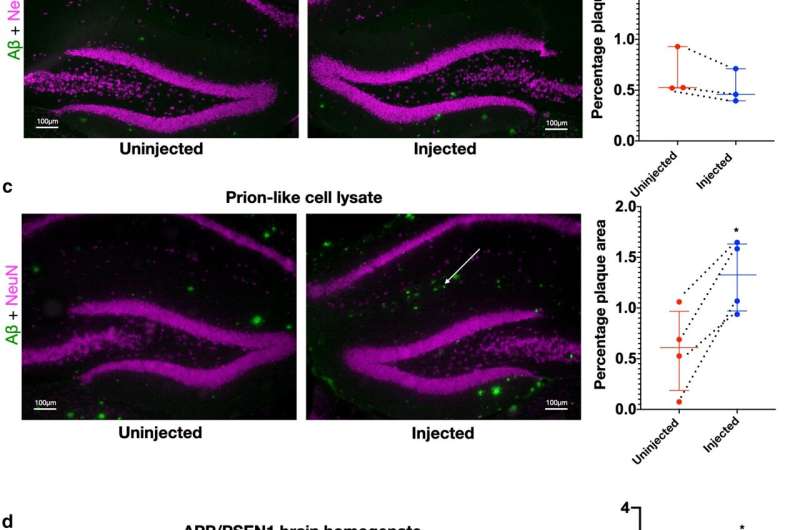Prion-like cell lysate seeds plaques in vivo. a Timeline of unilateral injections into hippocampus of 7-week-old 5xFAD mice, followed by labeling at 23 weeks with MOAB2 (Aβ, green) and NeuN (neuronal cell bodies, magenta). b Unilateral injection in hippocampus of 5xFAD transgenic mouse with lysate of APPSwe N2a cells. Plaque quantification of the upper parts of the dentate molecular layer, and CA1 stratum lacunosum-moleculare and stratum radiatum (paired t test with Bonferroni correction, p = 0.18, df = 2, mean difference = 0.14 and SD of mean difference = 0.076, dashed lines indicate paired data and n = 3). c Mouse injected with cell lysate of prion-like cells. The induced plaques are found adjacent to the hippocampal fissure (arrow). Plaque quantification paired t test with Bonferroni correction, p = 0.026, df = 3, mean difference = 0.72 and SD of mean difference = 0.27, dashed lines indicate paired data and n = 4. d 5xFAD mouse injected with brain homogenate from a 21-month-old transgenic mouse with APP/PSEN1 mutations showing plaque seeding around the dentate gyrus on the injected side (paired t test, p = 0.0396, df = 2, mean difference = 1.61 and SD of mean difference = 0.57, dashed lines indicate paired data and n = 3). Credit: DOI: 10.1007/s00401-021-02345-9
An experimental study from Lund University in Sweden has revealed that the Alzheimer's protein amyloid-beta accumulates inside nerve cells, and that the misfolded protein may then spread from cell to cell via nerve fibers. This happens at an earlier stage than the formation of amyloid-beta plaques in the brain, something that is associated with the progression of Alzheimer's disease.
The study in question builds on previous research based on amyloid-beta's prion-like properties. This means that the protein adopts a misfolded form that acts as a template for spreading in the brain, where it accumulates and develops plaques.
"The plaques of amyloid-beta outside the nerve cells have long been a target for treatment of Alzheimer's disease. But as treatments to remove plaque have not helped against dementia, we must develop and investigate other hypotheses in order to find other targets for treatment. Our results indicate that amyloid-beta is highly relevant, but that we must focus on misfolded amyloid-betainside the nerve cellsthat arise far earlier than the visible plaques," says the first author of the study Tomas Roos, doctoral student at Lund Universityand resident physician at Skåne University Hospital's neurological clinic.
Amyloid-beta is present in the brain of healthy individuals, but the mechanisms that are disrupted and cause the misfolding remain unclear. The plaques are extracellular, but the results of this study indicate that a misfolding can occur within the cells. Furthermore, the researchers show that there is a continuous exchange of amyloid-beta between the outside and inside of nerve cells, a kind of equilibrium, that is disturbed when misfolded amyloid-beta accumulates both inside and outside nerve cells.
In the study, which was conducted using a mouse model for Alzheimer's and cell culture, the researchers also noted that misfolded amyloid-beta inside the nerve cells leads to increased amyloid-beta production.
"The increased amyloid-beta caused by misfolded amyloid-beta inside cells can bring about a vicious circle of more and more amyloid-beta production. This could explain the enormous amounts of amyloid-beta that accumulate in the brain of Alzheimer's patients.First and foremost, the study results are to be replicated in a different Alzheimer's model. However, our results indicate that many of amyloid-beta's damaging effects may be caused by what is happening within the cells, independent of plaques. This may explain why so many experimental treatments targeting plaques outside the nerve cells have failed and that we should focus our attention inwards," concludes Tomas Roos.
More information: Tomas T. Roos et al, Neuronal spreading and plaque induction of intracellular Aβ and its disruption of Aβ homeostasis, Acta Neuropathologica (2021). DOI: 10.1007/s00401-021-02345-9
Provided by Lund University























